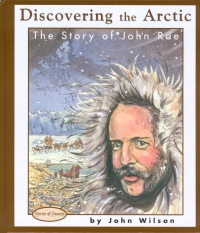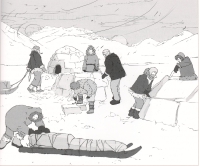| ________________
CM . . .
. Volume X Number 12. . . . February 13, 2004
excerpt:
This excerpt from Discovering the Arctic illustrates a few of the problems with this biography of arctic explorer John Rae. The text is long on detail and short on explanation. Encountering this passage, a young reader - or any reader, really, myself included - might have a number of questions, none of which are answered. Why did Rae receive a degree from McGill in Sault Ste. Marie? Why was a medical degree given as reward for exploration? When and where did he make the statement that "a few questions on medical subjects would have floored" him, and what does this statement mean? Did he mean that only a few medical questions would have floored him, or did he mean that he was no longer fit to practice medicine? The careful reader might remember Letitia Hargrave from a brief description some twenty pages earlier, but why is this bizarre reference to her death tacked onto the paragraph?
It is hard to determine the intended audience for Discovering the Arctic. The press release states that the book "should appeal to all children from the age of nine up," but seventy-five text-heavy pages, ambiguously captioned photographs, crude maps and grayscale illustrations seem unlikely to appeal to anyone. Illustrations need not be in colour, but they should be detailed and relevant, or at least engaging and attractive. Throughout, page layout and graphic design are unimaginative and occasionally confusing. Printed in double columns, the left-hand column sometimes provides contextual information, sometimes it is an extended caption to an illustration or photograph, and sometimes it must be read in conjunction with the main text, printed in the right-hand column, to be comprehensible. Worse, sometimes the main narrative migrates into the left-hand column, with the right-hand column providing supporting detail. Readers are likely to become confused and frustrated. The book has neither index nor table of contents. This means that references to recurring minor personalities, like Letitia Hargrave above, are difficult to follow, and passages treating specific themes or subjects are hard to locate. Specialized vocabulary generally is explained when it first occurs, but the lack of a glossary means that those readers who forget what the HBC was, or what a kabloona is, or who the voyageurs were, are out of luck. Without such basic bibliographic apparatus, students will find the book difficult to use for school reports. Author John Wilson has a good story on his hands, and his passion for Rae's unjust exclusion from the pantheon of great explorers is clear. Nonetheless, this book needs to be shorter or less dense, to have a clearer central narrative, to have better maps, to have an index, table of contents, and glossary, and to have better illustrations. Unless your patrons need to write reports on John Rae, or unless arctic exploration is the specific collecting focus of your library, there is no reason to add this book to your collection. Not Recommended. Greg Bak is an Information Specialist with the Canadian Public Health Association in Ottawa, ON.
To comment
on this title or this review, send mail to cm@umanitoba.ca.
Copyright © the Manitoba Library Association. Reproduction for personal
use is permitted only if this copyright notice is maintained. Any
other reproduction is prohibited without permission.
NEXT REVIEW |TABLE OF CONTENTS FOR THIS ISSUE
- February 13, 2004.
AUTHORS
| TITLES | MEDIA REVIEWS
| PROFILES
| BACK ISSUES
| SEARCH | CMARCHIVE
| HOME |

 Discovering the Arctic has an interesting story to tell, but it suffers from a rambling narrative and poor presentation. Born on Scotland's Orkney Islands in 1813, Rae was destined to make his mark in the Canadian north. Hired by the Hudson Bay Company as a doctor, Rae's skills as an outdoorsman and on the open water, as well as his singular ability to adapt to harsh conditions, induced the Company to train him as an arctic explorer. In 1845, as the British government outfitted the doomed Franklin expedition, charged with the discovery of the Northwest Passage, the Company sent Rae on the same mission. Where Franklin met only adversity and death, Rae, open-minded and sufficiently canny to learn rather than scorn the survival techniques of the local Inuit, not only survived but added thousands of kilometers of northern shoreline to European maps. Word of Rae's success spread, and in years to come he would be sent on repeated missions to learn the fate of the Franklin expedition. Nonetheless, when Rae finally reported tales of madness and cannibalism among Franklin's crew, stories told to him by the Inuit, Rae was disbelieved, ridiculed and shunned. Rae's reputation never recovered from this calumny, even after his account of the demise of the Franklin expedition was proven true.
Discovering the Arctic has an interesting story to tell, but it suffers from a rambling narrative and poor presentation. Born on Scotland's Orkney Islands in 1813, Rae was destined to make his mark in the Canadian north. Hired by the Hudson Bay Company as a doctor, Rae's skills as an outdoorsman and on the open water, as well as his singular ability to adapt to harsh conditions, induced the Company to train him as an arctic explorer. In 1845, as the British government outfitted the doomed Franklin expedition, charged with the discovery of the Northwest Passage, the Company sent Rae on the same mission. Where Franklin met only adversity and death, Rae, open-minded and sufficiently canny to learn rather than scorn the survival techniques of the local Inuit, not only survived but added thousands of kilometers of northern shoreline to European maps. Word of Rae's success spread, and in years to come he would be sent on repeated missions to learn the fate of the Franklin expedition. Nonetheless, when Rae finally reported tales of madness and cannibalism among Franklin's crew, stories told to him by the Inuit, Rae was disbelieved, ridiculed and shunned. Rae's reputation never recovered from this calumny, even after his account of the demise of the Franklin expedition was proven true.